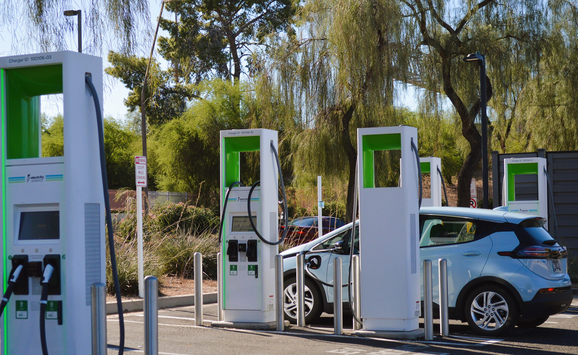RFF Senior Fellow Josh Linn explores why consumer demand for electric vehicles needs to take off soon, if we’re going to reach 100 percent market share within the next decade or two.
Based on recent headlines, the US electric vehicle (EV) market seems poised for explosive growth. During Tesla’s Battery Day event this September, CEO Elon Musk promised an electric car that would cost $25,000 within three years based on cost-cutting battery improvements. The next day, California joined several European countries in announcing future bans on the sale of new passenger vehicles that run on gasoline or diesel fuel. November’s victory for Joe Biden provides more good news: the president-elect has signaled his support for a massive scaling-up of EV sales by implementing tighter fuel economy standards, directing the federal procurement system toward zero-emissions vehicles, and deploying some 500,000 charging stations throughout the country over the next decade.
But an all-EV future faces many hurdles, including one basic problem: so far, all vehicle manufacturers except for Tesla have struggled to sell EVs. In this blog post, I’ll explore why consumer demand for EVs needs to take off soon, if we’re going to reach 100 percent market share within the next decade or two.
The Electric Vehicle Market in the United States
One strategy carmakers have used to sell EVs is introducing a plug-in hybrid, or all-electric version of an existing model, such as the Toyota Prius, Ford Focus, Hyundai Sonata, and Volvo XC60. It’s a sensible strategy, especially for plug-in hybrid vehicles. Manufacturers can start with the existing vehicle architecture and then modify a gasoline power train accordingly.
Figure 1 and Figure 2 show that for the most part, though, this strategy hasn’t been terribly effective at selling EVs. Figure 1 looks at examples of car companies that sell both electric and gas-powered versions of the same car model and assesses the share of sales attributable to the electric version. (We look at the second year to allow the manufacturer to ramp up production and advertising.) For example, when BMW offers an EV version and a non-EV version of the same model, the EV version accounts for about 11 percent of that model’s shares (Figure 1). Overall, EVs account for roughly 10 percent of total model sales across companies.
Figure 1
Figure 2 considers the specific cases of the Toyota RAV4 and the Toyota Prius. The Prius is perhaps the most successful example of this strategy, with an EV market share of almost 40 percent by the end of the second year. By contrast, RAV4 EV sales were close to zero. Toyota stopped selling the RAV4 EV after a few years but just recently decided to give it another try by introducing a new plug-in hybrid version.
Figure 2
Given that EVs haven’t sold well when consumers can compare them directly with a non-EV version of the model, manufacturers may start to diversify their strategies. For example, last year Volkswagen brought to market its stand-alone Audi e-tron, joining the Nissan LEAF, Chevrolet Volt, and all the Teslas as car models without a gas-powered equivalent.
Lower Battery Prices
Manufacturers also are pinning their hopes on technological improvements that will make EVs more cost-competitive with non-EVs. Tesla’s goal of bringing a $25,000 car to market rests largely on changes in battery design that would halve the cost per kilowatt hour (kWh, a unit of measurement that represents the energy needed to drive a car about three miles).
I’ll explore how these improvements might affect the EV market by making two assumptions. First, battery prices will continue to fall. They’ve dropped 90 percent over the last decade, so let’s suppose prices decline another 50 percent over the next five years—from today’s price of about $150 per kWh to $75 per kWh. This assumption is consistent with projections—and, if anything, a bit more optimistic than many.
To understand the implications of lower prices, it’s helpful to consider a few examples. A Nissan LEAF, with a sticker price of about $32,000, has a battery capacity of 40 kWh. Lower battery prices would reduce the cost of producing a LEAF by $3,000. For a Tesla Model 3, which has a sticker price of about $35,000 and battery capacity of 75 kWh, the drop in battery prices would reduce the cost of producing a Model 3 by $5,625.
My second assumption is that current subsidies for EVs from federal, state, and local governments will not last forever. Currently, if you buy an EV sold by any manufacturer whose total EV sales fall under 200,000 units—true for all carmakers except GM and Tesla—you can get a federal tax credit of up to $7,500. On top of the federal tax credit, many states offer subsidies of a few thousand dollars. Other perks, such as HOV lane access, are also common.
The fact that these subsidies will end once EV market shares reach a certain level makes it less likely that the anticipated drop in battery costs will spur significantly more EV purchases. As the calculations above indicate, the drop in battery price roughly offsets the loss of the federal tax credit—and thus may not provide a necessary jolt to consumer demand.
What does all this mean for public policy? One view is that we’ll have to provide generous subsidies for a long time before the market share increases, even with anticipated battery cost reductions. On the other hand, many consumers appear to be unfamiliar with the workings of the EV technology, and dedicated public information campaigns may also help. Major infrastructure investments also will be needed, which I’ll explore in a forthcoming blog post.
One way or another, even with anticipated battery price reductions, consumers need to grow a lot more excited about EVs if governments and manufacturers are going to achieve their goals of selling only EVs within the coming decades.
This article also appears on the University of Maryland’s Transportation Economics and Policy Blog, which is supported in part by funding through the Maryland Transportation Institute.






